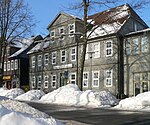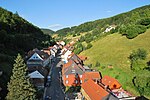Oberharz (Samtgemeinde)
Former Samtgemeinden in Lower SaxonyGoslar (district)Goslar district geography stubsPages with German IPA
Oberharz (German pronunciation: [ˈoːbɐhaːɐ̯ts]) is a former Samtgemeinde ("collective municipality") in the district of Goslar, in Lower Saxony, Germany. It was situated in the western part of the Harz, approx. 15 km southwest of Goslar. Its seat was in the town Clausthal-Zellerfeld. It was disbanded in January 2015, when its member municipalities merged into the town Clausthal-Zellerfeld. The Samtgemeinde Oberharz consisted of the following municipalities: Altenau Clausthal-Zellerfeld Schulenberg im Oberharz Wildemann
Excerpt from the Wikipedia article Oberharz (Samtgemeinde) (License: CC BY-SA 3.0, Authors).Oberharz (Samtgemeinde)
Osteröder Straße,
Geographical coordinates (GPS) Address Nearby Places Show on map
Geographical coordinates (GPS)
| Latitude | Longitude |
|---|---|
| N 51.803055555556 ° | E 10.332777777778 ° |
Address
Mäc-Geiz
Osteröder Straße 3
38678 , Clausthal (Clausthal-Zellerfeld)
Lower Saxony, Germany
Open on Google Maps











